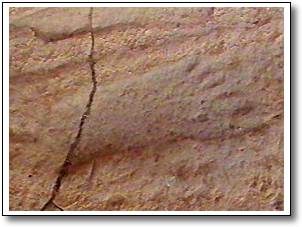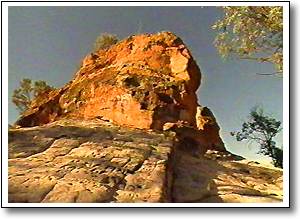ARAMAC GRAY ROCK
Aramac Attractions :: Aramac
Tramway :: Captain Starlight
Aramac Grey Rock
:: Aramac Lakes ::
Aramac Range ::
Muttaburra
Muttaburrasaurus Langdoni
:: Muttaburra Museum :: Union Hole & Union Camp
The sandstone Gray Rock is said to be part of the Doncaster member of the Wallumbilla formation which was
laid down in the lower Cretaceous period (about 125 million years ago) on a small marine shelf.
About 60 million years later, severe weathering conditions cauterized large areas inland Queensland, this area included.

Gray Rock is linked closely with the pioneering families who came to this vast sheep and cattle grazing country.
On the eastern side of the rock can be found some Aboriginal rock art.
Gray Rock, situated on a spur of the Great Dividing Range approximately 3kms east of Aramac, was a logical choice for the
establishment of a hotel or better known as wayside pubs where the Cobb & Co coaches would call for the night enroute from
Clermont to Aramac before the central-western railway line was completed. This railway, snaking from Rockhampton, reached
Jericho on 2 June, 1885 and Barcaldine on 7 July, 1886.
Old-timers related that there was little left of the hotel even in the late nineteenth century. It is known that a Mr Thomas
Byrnes in 1877 was installed as the first licensee and held same until 6 March, 1881, when it was transferred to a Mr Archibald
Casey, who subsequently sold to a Mr James Ferguson on 10 February, 1882. Ferguson closed the hotel on 22 December, 1885.

As Gray Rock was a mail change, fresh horses were kept in Mailman's Gorge, situated 3 kms south-east of the rock. With only one entry, the gorge was a horse tailers dream because the horses could be watered and mustered with a minimum of riding.
It would be safe to say that from the names carved into the gray sandstone outcrop, there would have been coach passengers who traveled for reasons best known to themselves, but never-the-less, what they left, together with those since added, it is a veritable who's who treasure.










